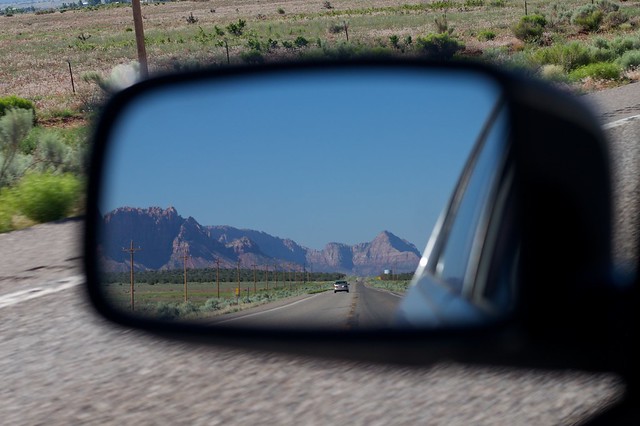Reflecting
How do you help your students reflect on your course and integrate what they’re learning into their subject knowledge and worldview? If you want your students to develop metacognition and self-understanding, or to articulate professional identity or a disciplinary perspective – reflection and reflective practice can help them integrate what they learn in your course into how they think.

Work found at https://www.flickr.com/photos/cogdog/4502048268/ / undefined
The Theory
The role of reflection in personal development and academic practice is widely acknowledged as a part of higher order thinking in general and also particularly in AACU’s VALUE rubric for Integrative Learning and rubric for Foundations and Skills for Lifelong Learning . The question is how we incorporate reflection in course design.
Adding it in
Adding reflection as a self-contained activity can be a great step, but we often add such activities as small items at the end of a course, or – from the student point of view – as an afterthought or the extra bit they need to do after they’re finished. Reflections done this way, though of potential benefit, can often easily lapse into superficial form-filling. A better approach is to build reflection into the course, and to scaffold student engagement with the process. This can be much more effective and changes how a student interacts with the reflective activity.

Work found at https://www.flickr.com/photos/cogdog/4708291454/ / undefined
An example: Current Problems in Sustainable Living (PS 399)
In PS 399 Current Problems in Sustainable Living (in the future to be offered as PS 374) Dr. Erika Wolters set out to engage students with the issue of their personal role in sustainability within the context of huge global political systems. The course description is as follows:
“Exploration of the role of individuals in sustainability practices and policies. Special focus is given to an examination of how individuals can make sustainable lifestyle choices in light of policy regulations, technologies, socio-economic conditions, and cultural values.”
The Final Paper
Dr Wolters had set set up her course with three major papers alongside other activities and assessments. Originally, the reflective activity was contained in the final paper which required
“By the end of week 2, please select three personal behaviors […] that you will try to change in order to live more sustainably. Document your starting point and each step along the way. Your final paper will require you to discuss your step-by-step attempts where you were successful, where you met with unexpected difficulties, or any other surprises along the way. Place your personal sustainability experience into the context of your readings about individual actions and impacts.“
This paper sought to integrate practice, reflection, and critical disciplinary analysis. As Dr. Wolters and I discussed the course design and how to help students engage with this activity in an online environment, we were aware of two pitfalls to avoid: students reaching the end of the course and struggling to remember their experience and students spending all of their final paper recounting their experience rather than critically engaging with it.
The redesign
The solution we came up with was to ask students to create journal entries throughout the course documenting and beginning to reflect on their practice. In the ten-week course, they identified their sustainable practice by week 2 and journaled about it in weeks 4, 6, and 8 before writing their final paper in week 10. The journal could either be in written or video diary format. There were any number of tools that could be used to support the video option, but using Canvas’ integrated tools and video recorder enabled students to do so easily and without the cognitive overhead of learning an external tool.
The journal could have been set up in a Canvas discussion board. This setup would have created a shared experience across the class in which students reflected and shared together. However, because the focus of this course was personal reflection, the journal activity was set up using the assignment tool. The video or text reflection was shared only with the professor. The reason for doing this was to create the opportunity for more personal reflections than the student might have felt comfortable posting in a forum.

Work found at https://www.flickr.com/photos/cogdog/5570581236/ / undefined
Work in progress
The course is still underway but halfway through I was able to catch up with Dr. Wolters to find out how it was going. Her key observations so far relate in large part to the changes developed through the availabilty of video as an option for this journal activity. She reported the following:
“I do think it is helping them think about the course differently. It is great having them undertake behavior/habit changes and reflect on the costs vs. benefits. It is really exciting to see how they are embracing the project!”
“[I]t is definitely helping me connect with the students differently. I really enjoy seeing and hearing them vs. just having the one-dimensional responses of the discussion boards.“
“[The video posts] were so much fun I responded with a video comment and then posted bi-weekly announcements as a video. It was fun! I definitely feel more connected to the students this way.”
Interim Conclusion
Although this activity needs further evaluation, it illustrates a way to engage students with academic reflection through encouraging dialogue early and throughout the course. From the initial feedback it seems clear that from the instructor’s perspective it offers opportunities to connect with students throughout the course and enable them to engage with the topic.
Image Credits
All images by Alan Levine (Flickr user Cogdog), used under a CC- BY licence.


Hi John, I found your blog article interesting and encouraging. Dr. Wolter’s work is spurring students to interact with course content on a personal level that requires students to reflect upon their behaviors. As they examine their behaviors, their beliefs may shift. Since beliefs drive human behavior…raised consciousness leads to the “transformative” learning. A great example of meeting our Strategic Goal #1.